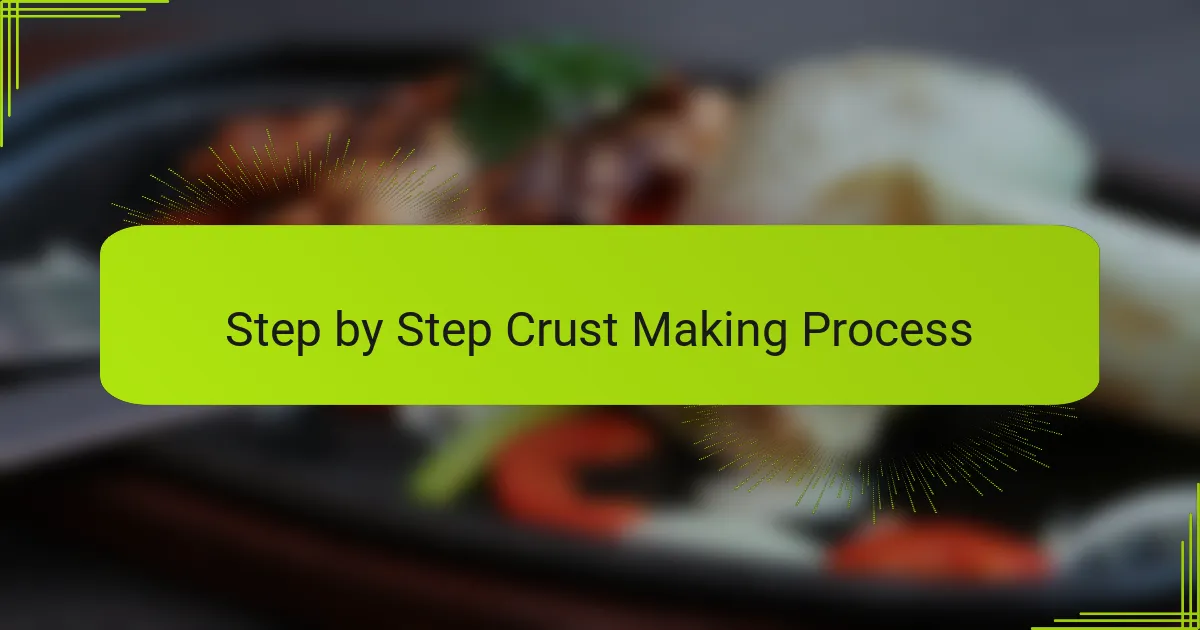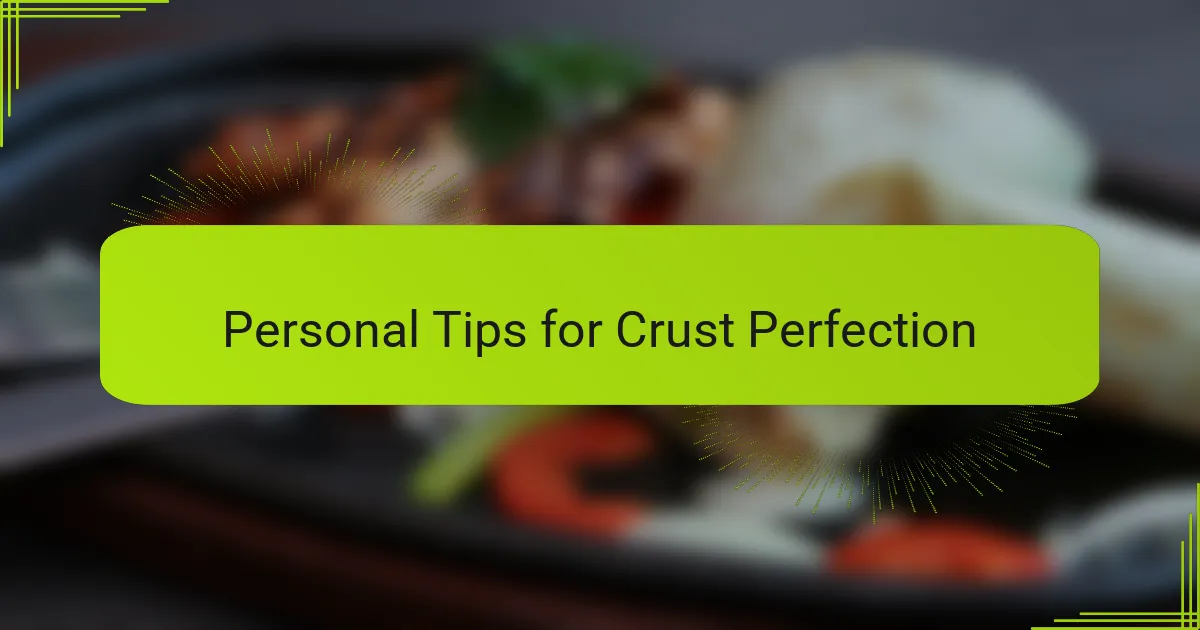Key takeaways
- A perfect crust enhances dessert quality; it requires the right ingredient mix, temperature control, and careful baking.
- Using Emile Henry pottery ensures even heat distribution, preventing burnt edges and improving crust texture.
- Preparation steps, like preheating the dish and lightly greasing, are crucial for achieving a flawless crust.
- Common crust issues can often be resolved by blind baking and allowing the dough to rest properly before baking.

Understanding Perfect Crust in Desserts
A perfect crust is more than just a base for your dessert—it’s the first impression, the crunch that sets the tone for every bite. I remember the frustration of soggy or overly tough crusts, which can turn a promising dessert into a disappointment. Have you ever wondered why some crusts bake into that ideal balance of flaky and firm while others fall flat?
For me, understanding the science behind the crust is key. It’s about the right mix of ingredients, temperature control, and knowing when to stop baking so that the crust doesn’t dry out. Each step plays a role in crafting that satisfying texture that complements your dessert filling without overpowering it.
What really makes a difference is how the crust feels when you cut into it—the gentle resistance before it crumbles softly in your mouth. Achieving this perfection requires patience and attention, but the payoff is worth it every time. After all, isn’t that golden crunch what keeps us coming back for another slice?

Benefits of Using Emile Henry
Using Emile Henry pottery has truly transformed how I bake my dessert crusts. The ceramic material distributes heat evenly, which means no more worrying about burnt edges or undercooked centers. I’ve noticed my crusts bake more uniformly, giving me that flawless crunch every time.
One of the things I appreciate most is the way Emile Henry retains heat even after being removed from the oven. This residual warmth helps set the crust beautifully, continuing the baking process gently. Have you ever pulled out a crust too soon, only to have it collapse or feel doughy? Emile Henry helps me avoid that pitfall completely.
Plus, there’s something satisfying about using such a high-quality, durable piece of cookware. It feels like an investment in both my kitchen and my baking results. When I use Emile Henry, I feel more confident that my desserts will come out consistently impressive, which makes the whole baking experience more enjoyable.

Preparing Your Emile Henry for Baking
Getting your Emile Henry ready for baking is surprisingly simple, but those small steps really set the stage for that perfect crust. I always make sure to preheat the ceramic dish along with the oven—this way, the heat is evenly absorbed, and my crust starts baking on contact, avoiding that frustrating soggy bottom. Have you tried sliding your dough into a cold dish before? The difference is night and day.
Before placing your dough, I like to lightly grease the Emile Henry or dust it with a bit of flour depending on the recipe. This little trick has saved me from stubborn crusts sticking and tearing apart when it’s time to serve. It might sound a bit finicky, but trust me, it’s worth the extra minute.
Finally, I sometimes prick the crust base with a fork—especially for pies with juicy fillings—to let steam escape. Emile Henry’s durable ceramic handles this perfectly without cracking under the stabbing. Preparing the dish carefully like this takes a little mindfulness, but when that golden, crisp crust emerges, it’s proof those moments mattered.

Step by Step Crust Making Process
The first step I take is mixing the dough just enough to bring the ingredients together without overworking it. Have you ever noticed how too much mixing can make the crust tough? I’ve learned that handling the dough gently preserves those flaky layers we crave.
Next comes rolling out the dough, which I do on a lightly floured surface to avoid sticking but without excess flour that could dry it out. I always remind myself to keep the thickness consistent—too thin, and the crust burns; too thick, and it feels doughy. This balance is something I perfected after many trial-and-error attempts.
Once the dough is in the Emile Henry dish, I prick the base with a fork to let steam escape during baking. It’s a small step, but crucial for preventing bubbles and sogginess. I find this creates a crust that’s evenly crisp, making every bite just right.

Troubleshooting Common Crust Issues
Sometimes my crusts turn out soggy, especially when the filling releases too much moisture. I learned that blind baking the crust—baking it partially before adding the filling—makes all the difference. Have you tried lining your crust with parchment paper and filling it with pie weights or dried beans? This trick lets the dough firm up and stay crisp.
Occasionally, I’ve battled a crust that feels tough and hard to cut through, which I find frustrating. Overworking the dough or baking at too high a temperature tends to be the culprit. I now remind myself to chill the dough before baking and keep the oven steady, which helps preserve that tender, flaky texture I’m after.
Ever had your crust shrink away from the edges of your dish? I used to think it was just bad luck. But I realized it usually happens when the dough isn’t rested properly or gets stretched too much when placed in the pan. Giving the dough time to relax before baking and avoiding excessive stretching keeps the crust snug and perfect every time.

Personal Tips for Crust Perfection
One tip that changed everything for me was chilling the dough before baking. I used to rush through that step, thinking it was just extra time wasted, but once I gave the dough proper rest, the crust became noticeably flakier and less prone to shrinking. Have you ever been surprised by how something so simple can make such a big difference?
I also swear by using cold butter and minimal handling when mixing the dough. It keeps the fat in tiny pockets, which creates that irresistible flakiness I crave. When I see those golden layers in the final crust, it feels like a little reward for my patience and care in the kitchen.
Lastly, I pay close attention to baking times and temperatures—even small adjustments can transform the crust’s texture entirely. I’ve learned to trust my instincts over the recipe’s numbers sometimes, especially when my Emile Henry dish communicates its heat so evenly. Isn’t it amazing how knowing your tools intimately helps you bake with more confidence?

Recommended Dessert Recipes with Emile Henry
When it comes to desserts, Emile Henry really shines with classics like fruit tarts and crème brûlée. I remember the first time I baked a raspberry tart in my Emile Henry dish—the crust was impeccably crisp, holding the juicy filling perfectly without any sogginess. Have you ever had a tart crust that just melts in your mouth? This cookware consistently delivers that experience.
Another favorite I recommend is a chocolate pecan pie. The even heat distribution helps the nuts toast beautifully while the crust bakes to a deep golden shade. I love how the Emile Henry ensures the edges don’t burn before the center is done, which used to be a challenge for me.
For those who enjoy experimenting, try a rustic galette with seasonal fruits. The Emile Henry’s ceramic surface gives the crust a robust crunch that contrasts deliciously with soft, sweet fillings. Honestly, I find that the more I use this dish, the more my dessert presentations feel professional—what’s not to love about that?




